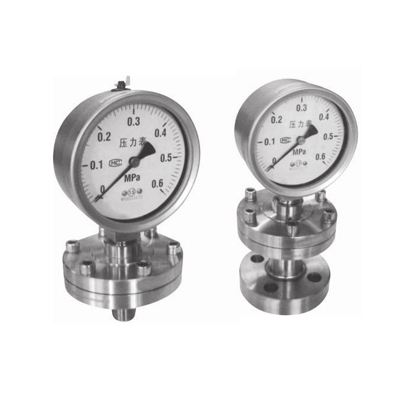Diaphragm pressure gauge
Description
I. directions for use:
The YMF diaphragm pressure gauge can be applied to measure the pressure of strong corrosion, high temperature, high viscosity, easy to crystallize, easy to solidify, and medium with solid floats, and to some measuring medium in order to expand the application range of all kinds of pressure meters. A diaphragm gauge consisting of diaphragm isolator and universal pressure instrument shall be used when pressure detection is not directly into the universal instrument and is easy to clean and prevent accumulation of precipitating substances.
The diaphragm gauge is mainly used for pressure detection during the production of petroleum, chemical, pharmaceutical, food and textile industries.
Two. The schematic diagram of diaphragm pressure gauge system:
Three, diaphragm pressure gauge structure principle:
Diaphragm pressure gauges consist of a variety of universal pressure meters and diaphragm separators with different structures.
When the pressure of the measured medium acts on the diaphragm, the diaphragm is deformed, and the sealing fluid in the sealing system is compressed.Because of the inherent nature of the sealing fluid,
The elastic deformation and displacement of the elastic element in the pressure instrument are displayed, and the pressure value is displayed through the indicating device. When the diaphragm stiffness is small enough,
The pressure indicated by the pressure gauge is close to the pressure value of the measured medium.
Four, the main technical indicators of diaphragm pressure gauge:
Temperature characteristic of diaphragm gauge
Because the sealing system of the diaphragm table is filled with the sealing fluid as the medium for pressure transmission, the temperature influence of the diaphragm and the expansion coefficient of the sealing liquid are caused.
The diaphragm stiffness is related to the temperature of the pressure part. The impact on low range pressure meters is particularly obvious. Generally, the temperature error of the compression part is not greater than 1.0%/ degrees, so the temperature influence of the diaphragm is generally determined by the sum of the temperature influence of the general pressure instrument and the temperature influence of the diaphragm isolator.
Liquid level difference of diaphragm gauge
Especially for diaphragm tables with soft connection tubes, the diaphragm pressure part is not on the same level as the universal pressure gauge.
The effect of liquid difference will be P. More attention should be paid to accurate measurement.
Corrosion resistance of diaphragm
The corrosion resistance of the diaphragm can be ensured by proper selection of the diaphragm, the flange and the gasket material of the contact part of the measuring medium.
Diaphragm materials: 0Cr17Ni12Mo2 (316); Monel alloy (Cu30Ni70); Hastelloy (H276C); tantalum (Ta) and fluoroplastics (F4).
Flange material: stainless steel 0Cr17Ni12Mo2 (316); stainless steel lined fluoroplastics (316+F4).
Sealing washer material: butadiene rubber, fluoroelastomer, silicone rubber and fluoroplastics.
Selection of diaphragm solution
To ensure the reliability and safety of diaphragm gauge, proper sealing fluid should be selected according to different uses.


